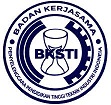Analysis of factors influencing the use of digital payments on student purchase levels using Structural Equation Modeling (SEM)
Abstract
Keywords
Full Text:
PDFReferences
“Sistem Pembayaran & Pengelolaan Uang Rupiah,” Bank Indonesia, 2018. https://www.bi.go.id/id/fungsi-utama/sistem-pembayaran/default.aspx
I. Almarashdeh, “An overview of technology evolution: Investigating the factors influencing non-bitcoins users to adopt bitcoins as online payment transaction method,” J. Theor. Appl. Inf. Technol., vol. 96, no. 13, pp. 3984–3993, 2018.
A. Hawari, A. Adriansyah, B. Brian, D. Grace Simanjuntak, and R. Susanto, “Faktor-Faktor yang Mempengaruhi Penggunaan Pembayaran Seluler di Jabodetabek,” PERWIRA - J. Pendidik. Kewirausahaan Indones., vol. 3, no. 2, pp. 93–116, 2020, doi: 10.21632/perwira.3.2.93-116.
B. Triyani, “Factors That Influence the Intensity of The Use of Digital Payment (Case Study In OVO Users),” EPRA Int. J. Multidiscip. Res. (IJMR)-Peer Rev. J., vol. 6, no. 6, pp. 89–99, 2020, doi: 10.36713/epra4614.
M. Ajouz, F. Abuamria, dan J. Hammad, "Factors Influencing Mobile Payment Adoption and Its Role in Promoting Financial Inclusion: An Integrated Reflective Model with Theory of Planned Behavior," in Innovation of Businesses, and Digitalization during Covid-19 Pandemic, B. Alareeni dan A. Hamdan, Eds. Cham: Springer International Publishing, 2023, hlm. 563–581. doi: 10.1007/978-3-031-08090-6_36.
J. F. Hair, G. T. M. Hult, C. M. Ringle, M. Sarstedt, N. P. Danks, and S. Ray. Partial least squares structural equation modeling (PLS-SEM) using R: A workbook. Springer Nature, 2021.
P. Fahlevi and A. O. P. Dewi, “Analisis Aplikasi Ijateng Dengan Menggunakan Teori Technology Acceptance Model (TAM),” J. Ilmu Perpust., vol. 8, no. 2, pp. 103–111, 2019.
S. R. Wicaksono, Teori Dasar Technology Acceptance Model, no. March. 2022. doi: 10.5281/zenodo.7754254.
R. H. Hoyle, The Structural Equation Modeling Approach: Basic Concepts and Fundamental Issues. In: Hoyle, R.H., Ed., Structural Equation Modeling: Concepts. Thousand Oaks: Sage Publications, 1955.
A. Purwanto and Y. Sudargini, “Partial Least Squares Structural Squation Modeling (PLS-SEM) Analysis for Social and Management Research : A Literature Review,” J. Ind. Eng. Manag. Res., vol. 2, no. 4, pp. 114–123, 2021.
D. K. Musyaffi, A. M. Khairunnisa, H. Respati, Konsep Dasar Structural Equation Model-Partial Least Square (SEM-PLS) Menggunakan SmartPLS. Pascal Books, 2022.
F. D. Davis, “Perceived usefulness, perceived ease of use, and user acceptance of information technology,” MIS Q. Manag. Inf. Syst., vol. 13, no. 3, pp. 319–339, 1989, doi: 10.2307/249008.
I. Ajzen, “The theory of planned behavior,” Handb. Theor. Soc. Psychol. Vol. 1, pp. 438–459, 1991, doi: 10.4135/9781446249215.n22.
L. Lieny, “Pengaruh Persepsi Kemudahan, Kenyamanan, dan Kepercayaan Terhadap Niat Dalam Menggunakan Mobile Banking di BCA Pangkalpinang,” J. Akunt. Bisnis dan Keuangan, STIE-IBEK, vol. 8, no. 2, pp. 56–62, 2021, [Online]. Available: www.stie-ibek.ac.id
O. T. Nguyen, “Factors affecting the intention to use digital banking in Vietnam,” J. Asian Financ. Econ. Bus., vol. 7, no. 3, pp. 303–310, 2020, doi: 10.13106/jafeb.2020.vol7.no3.303.
I. M. G. A. Kurniawan, "Sikap dan Minat Menggunakan Mobile Banking (Studi Kasus pada PT. Bank Pembangunan Daerah Bali Cabang Denpasar)," Ganaya: Jurnal Ilmu Sosial dan Humaniora, vol. 2, no. 2, pp. 492–502, Sep. 2019.
B. M. Teka, “Factors affecting bank customers usage of electronic banking in Ethiopia: Application of structural equation modeling (SEM),” Cogent Econ. Financ., vol. 8, no. 1, 2020, doi: 10.1080/23322039.2020.1762285.
N. Arthana, Y. W., & Rukhviyanti, “Pengaruh Minat Individu Terhadap Penggunaan Mobile banking (M-Banking): Model Kombinasi Technology Acceptance Model (TAM) dan Theory of Planned Behavior (TPB),” J. Inf., vol. VIII, no. 1, pp. 25–44, 2015.
F. Sodik, A. Nur Zaida, and K. Zulmiati, “Analisis Minat Penggunaan pada Fitur Pembelian Mobile Banking BSI: Pendekatan TAM dan TPB,” J. Bus. Manag. Islam. Bank., vol. 1, no. 1, pp. 35–53, 2022, doi: 10.14421/jbmib.2022.011-03.
W. Senalasari, W. Rafdinal, and A. Qisthi, “Peran Kesiapan Teknologi Dalam Minat Menggunakan Aplikasi Pembayaran Seluler Di Masa Pandemi Covid-19,” J. Ris. Bisnis dan Investasi, vol. 7, no. 1, pp. 22–32, 2021, doi: 10.35313/jrbi.v7i1.2266.
N. Nurdin, R. Ningrum, S. Bachmid, dan A. Jalil, "Pengaruh Manfaat, Kepercayaan, dan Kemudahan Penggunaan terhadap Minat Nasabah Menggunakan Mobile Banking di Bank Mega Syariah Cabang Palu," Jurnal Ilmu Pengetahuan Sosial dan Humaniora, vol. 3, no. 1, hlm. 87–104, 2020.
Riska, “Pengaruh Digital Payment Terhadap Perilaku Konsumtif Mahasiswa FEBI IAIN PAREPARE (Analisis Ekonomi Islam),” IAIN Pare Pare, pp. 1–23, 2022.
Sugiyono, Metode Penelitian Kualitatif Kualitatif. 2019.
I. Ghozali, Aplikasi Analisis Multivariete Dengan Program IBM SPSS 23. Badan Penerbit Universitas Diponegoro, 2016.
W. W. Chin, "The partial least squares approach to structural equation modeling," in Modern Methods for Business Research, G. A. Marcoulides, Ed. Mahwah, NJ: Lawrence Erlbaum Associates, 1998, pp. 295–336.
Pranoto, “Model pengukuran reflektif dan formatif dalam structural equation modeling dengan teknik partial least square (SEM-PLS),” Fakultas Matematika dan Ilmu Pengetahuan Alam, Universitas Lampung, Bandar Lampung, Indonesia, 2019.
N. P. A. S. Maryani, N. L. K. S., Widyani, A. A. D., dan Saraswati, “Pengaruh kompensasi finansial terhadap kinerja karyawan dengan motivasi sebagai variabel intervening pada PT Arta Sedana Retailindo Cabang Hardys Malls Sanur,” Value J. Ilm. Manaj., Ekon., Akunt., vol. 3, no. 2, hlm. 188–199, 2023.
A. Rachmawati, “Faktor-Faktor Yang Mempengaruhi Minat Menggunakan Layanan Mobile Payment Dalam Bertransaksi,” Doctoral dissertation, Universitas Islam Indonesia 2019.
S. K. Ariffin and K. T. Lim, “Investigating Factors Affecting Intention to Use Mobile Payment Among Young Professionals in Malaysia,” no. 141, pp. 6–11, 2020, doi: 10.2991/aebmr.k.200514.002.
P. J. Morgan and L. Q. Trinh, “Determinants and Impacts of Financial Literacy in Cambodia and Viet Nam,” J. Risk Financ. Manag., vol. 12, no. 1, 2019, doi: 10.3390/jrfm12010019.
DOI: http://dx.doi.org/10.62870/jiss.v10i2.28798
Refbacks
- There are currently no refbacks.
 is supported by
is supported by








